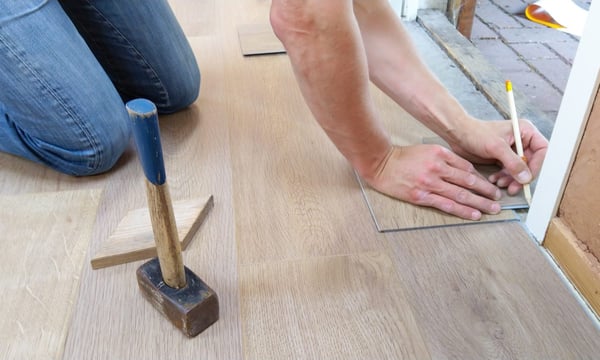Flooring is an important consideration when building residential properties, if for no other reason than the sheer amount of square footage it occupies. As a builder or investor, you know that there are numerous materials on the market and that cost, trends, availability, and green considerations all affect flooring choices, but perhaps you’ve never thought of flooring in great detail. Below is a look at some of the most common (and some less common) options on the market, and an explanation of each.
Natural Stone
Natural stone includes slate, marble, limestone, granite, and travertine. It is prized for its aesthetics but is more expensive than engineered stone. It is also worth noting that some types of natural stone can be quite delicate, and that more porous stones, such as marble, are not suitable for areas where moisture could be an issue. Marble can also stain quite easily and requires more maintenance than most other natural stone. For these reasons, consider using natural stone as an accent to add value to your builds, but use some of the other, more practical options listed below in high traffic areas.
Engineered Stone
Engineered stone has a similar look to natural stone but is made up of crushed stone and adhesives. Because it is man-made, most manufacturers offer a very wide range of colors and styles, many of which mimic natural stone. Unlike natural stone, engineered stone is designed to be completely non-porous, so moisture is never an issue. It is also cheaper than natural stone is designed to be extremely durable and easy to clean.
Solid Hardwood Flooring
Solid hardwood flooring is made from 100% solid wood. Common types include oak, walnut, or maple. While solid hardwood is more expensive than engineered hardwood, it also has a much longer lifespan. Solid hardwood can last many decades and can be sanded and refinished numerous times. Maintenance is relatively easy for solid hardwood but it can warp over time if it comes into contact with moisture for prolonged periods. Buyers do tend to like solid hardwood, so it is definitely a material that can add value to your build and give you a bigger return on investment. On average, solid hardwood flooring costs about $8-$15 per square foot.
Engineered Hardwood Flooring
Like engineered stone, engineered wood is made up of a few different materials. Most engineered hardwood flooring contains a thin top layer of hardwood (the part that is seen) with plywood underneath. It is less expensive than solid hardwood and is generally designed to mimic it. Because it is engineered, many different colors and finishes are usually available. Maintenance is comparable with solid hardwood but installation is slightly easier.
While solid hardwood needs to be nailed down, some types of engineered hardwood use a click-together system, eliminating the need for nails. If you're looking to spend less on both flooring materials and installation costs, this is a good option for your builds, as it is much less than solid hardwood, at about $3-$5 per square foot. However, while the upfront costs are less, it will not add the same value as hardwood.
Other Types of Flooring
Some other types of flooring which are still readily available include bamboo, cork, concrete, vinyl, and linoleum. Bamboo is prized for its green aspects as it is a highly sustainable and abundant wood. Cork flooring is made of the bark of trees, and is also highly sustainable and slightly cheaper than solid hardwood flooring. However, cork does require sealing upon installation and is not as durable as many of the other flooring options discussed.
Concrete flooring is a very popular choice in some types of builds such as lofts due to its industrial aesthetic. Concrete is extremely durable, inexpensive, easy to maintain, and can be dyed in virtually any color. When poured it creates a continuous surface eliminating the need for complex installation aside from flattering and sealing. It is an excellent choice for lofts or industrial inspired spaces, as buyers interested in these types of residences are looking for just that. Many developers have been using concrete as a flooring material in loft developments for years and this trend shows no signs of slowing down.
Finally, linoleum and vinyl are worth mentioning as they are often thought to be very similar but have some key differences. Linoleum is made of natural materials including linseed oil, resin, cork dust, and minerals. Linoleum is also sold in sheets and cut be cut to create tiles or be laid down as a full sheet.
Unlike linoleum, vinyl is a synthetic material made from PVC and adhesives. It has more variety than linoleum in that it can be manufactured in sheets, tiles, or planks, and in different degrees of thickness and durability. It is slightly more expensive than linoleum, but also more durable over time. However, with the increased popularity of green materials, many consumers may no longer want a PVC material in their living spaces.

Recent Posts
- Spec Home Loans: Complete Guide to Construction Financing for Builders
- Spec Construction Loans: A Spec Line of Credit Is Worth the Paperwork
- Spec Homes and Pre-Sale Homes: Relative Benefits for a Spec Builder
- Spec Construction Success: Insights for the Investor Builder
- How Is a Spec House Different From Other Kinds of House Construction?
